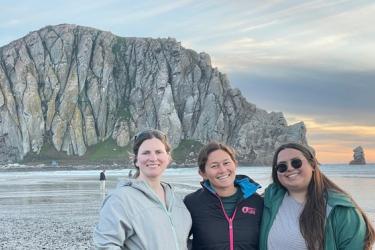I have to admit, despite always knowing I wanted to be a marine biologist, I never thought I would go into the field of acoustics. I didn't realize it was an option until partway through my freshman year of college. But during a Zoom interview for the Hollings Preparation Program (HPP), I heard about Shannon Rankin’s work at the Southwest Acoustic Ecology Lab and I knew this was something I had to learn more about.
Hi, my name is Maya Philipp, and I’m a UC San Diego undergraduate student. I first started working with Southwest Fisheries Science Center as an HPP intern during the summer of 2021 and fell in love with the field of acoustics. I worked for 6 weeks manually annotating data from the California Current Ecosystem to create a ground truth dataset to compare to an automatic detector. Humans tend to be much better at picking out and classifying sounds, so it’s helpful to create this dataset to judge the automatic detector’s performance. I worked with everyone’s favorite marine mammal, humpback whales. Their massive range of calls and song is what makes them so fascinating and beloved, but this also means automatic detectors have a hard time identifying and classifying their calls. I worked through 10 days of data, boxing calls that I found to later compare to an automated detector doing the same thing. Through that data, I learned so much about the ocean, and realized how much more there is to discover. It was always surprising to me when I showed my mentors an interesting sound, and there was not always a clear answer as to what it was.
It’s both comforting and exciting to see how much more the world of acoustics can grow, and that I won’t be stepping into a stagnant field. Although I’m no longer an HPP intern, I am still working with the Southwest Acoustic Ecology Lab doing similar tasks. I am now going through data and not only identifying, but attempting to classify stereotypic humpback calls whenever I can. I still enjoy going through the audio files and listening to all the fascinating sounds in the ocean.
I’ve had the opportunity to meet many amazing people through this work, reaching far and wide. It is these scientists who are willing and excited to share their knowledge with me. Although I’m still deciding where my career will take me, I know I will always have a home in acoustics.
Through all this interesting work, I can’t help but remember how I stumbled on the field by chance. Tiny inconsequential choices led me to a field I knew nothing about. I wasn’t expecting to get into research in my undergraduate years, let alone in acoustics. Despite all of my time at aquariums and touring colleges, it never occurred to me that I could study sounds. That’s why I think it is so important to get students involved in research, in science as early as possible to open their eyes to all the different opportunities they can grab hold of. Programs like HPP and others are crucial to keeping the most common and the niche of fields within marine biology (including acoustics) alive. In order to keep the stream of young scientists flowing into crucial work such as this, they need to know it exists. More students than ever are interested in STEM and in research, so now is the best time to introduce them to acoustics.




